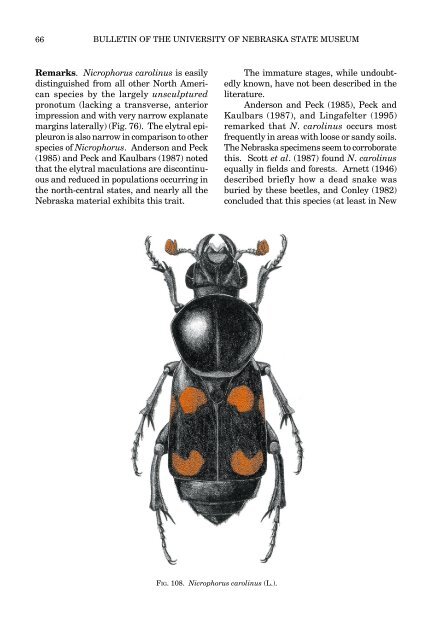Download full text - University of Nebraska State Museum
Download full text - University of Nebraska State Museum
Download full text - University of Nebraska State Museum
You also want an ePaper? Increase the reach of your titles
YUMPU automatically turns print PDFs into web optimized ePapers that Google loves.
66<br />
BULLETIN OF THE UNIVERSITY OF NEBRASKA STATE MUSEUM<br />
Remarks. Nicrophorus carolinus is easily<br />
distinguished from all other North American<br />
species by the largely unsculptured<br />
pronotum (lacking a transverse, anterior<br />
impression and with very narrow explanate<br />
margins laterally) (Fig. 76). The elytral epipleuron<br />
is also narrow in comparison to other<br />
species <strong>of</strong> Nicrophorus. Anderson and Peck<br />
(1985) and Peck and Kaulbars (1987) noted<br />
that the elytral maculations are discontinuous<br />
and reduced in populations occurring in<br />
the north-central states, and nearly all the<br />
<strong>Nebraska</strong> material exhibits this trait.<br />
Fig. 108. Nicrophorus carolinus (L.).<br />
The immature stages, while undoubtedly<br />
known, have not been described in the<br />
literature.<br />
Anderson and Peck (1985), Peck and<br />
Kaulbars (1987), and Lingafelter (1995)<br />
remarked that N. carolinus occurs most<br />
frequently in areas with loose or sandy soils.<br />
The <strong>Nebraska</strong> specimens seem to corroborate<br />
this. Scott et al. (1987) found N. carolinus<br />
equally in fields and forests. Arnett (1946)<br />
described briefly how a dead snake was<br />
buried by these beetles, and Conley (1982)<br />
concluded that this species (at least in New
















